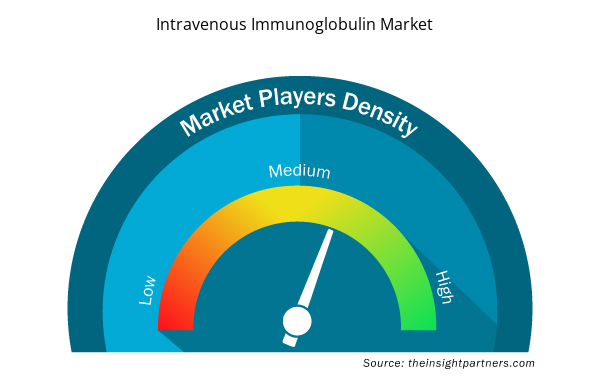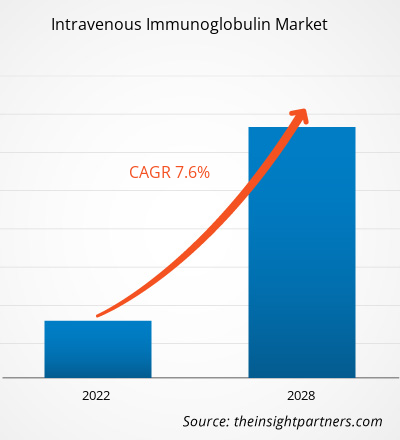2021 年静脉注射免疫球蛋白市场价值为 112.0654 亿美元,到 2028 年可能达到 186.7255 亿美元;预计 2022 年至 2028 年的复合年增长率为 7.6%。
免疫球蛋白是人体免疫系统自然产生的抗体,有助于抵抗感染和疾病。免疫球蛋白缺乏需要外部注射免疫球蛋白,这被称为免疫球蛋白替代疗法 (IgRT)。IgRT 可通过静脉和皮下注射进行。静脉注射免疫球蛋白 (IVIg) 和皮下注射免疫球蛋白 (SCIg) 是根据适应症和严重程度来选择的。IVIg 由人血浆制成。它含有抗体,用于治疗越来越多的免疫、血液和神经系统疾病。
静脉注射免疫球蛋白市场按类型、应用、分销渠道、最终用户和地域进行细分。按地域划分,市场大致分为北美、欧洲、亚太地区、中东和非洲以及南美和中美洲。本报告提供了对市场的见解和深入分析,强调了市场趋势、市场动态和全球领先市场参与者的竞争分析等参数。
定制此报告以满足您的需求
您可以免费定制任何报告,包括本报告的部分内容、国家级分析、Excel 数据包,以及为初创企业和大学提供优惠和折扣
- 获取此报告的关键市场趋势。这个免费样品将包括数据分析,从市场趋势到估计和预测。
市场洞察
免疫缺陷疾病患病率的上升和老年人口的增加正在推动静脉注射免疫球蛋白市场的发展。
根据美国国家过敏和传染病研究所 (NIAID) 的数据,美国约有 50 万人患有 200 多种不同类型的原发性免疫缺陷病 (PIDD)。这种罕见的遗传病可能是慢性的、虚弱的并且花费昂贵。免疫性血小板减少症 (ITP) 是一种自身免疫性出血性疾病,其特征是血小板水平异常低;这种情况称为血小板减少症。根据罕见疾病组织的数据,全球每年记录的 ITP 病例约为 20 万例。此外,根据联合国人口司的《2019 年世界人口前景》,亚洲和欧洲国家拥有世界上一些 65 岁及以上的老龄人口。日本以 28% 的比例位居榜首,其次是意大利,为 23%。此外,芬兰、葡萄牙和希腊是老龄人口比例低于 22% 的前五个国家。许多接受 IVIG 治疗的患者年龄在 60 岁以上。随着年龄的增长,产生 T 细胞抵抗疾病的能力显著下降。因此,老年人的身体很容易感染多种感染和疾病,这增加了对涉及使用 IVIg 的免疫疗法的需求。因此,全球免疫缺陷疾病的增加和老年人口的增加正在推动静脉注射免疫球蛋白市场的发展。
基于类型的洞察
根据类型,静脉注射免疫球蛋白市场细分为 IgG、IgM、IgA、IgE 和 IgD。IgG 型免疫球蛋白细分市场在 2021 年占据了最大的市场份额。然而,由于 IgG 在治疗多种疾病方面应用广泛,预计手持细分市场在预测期内的复合年增长率最高。
基于应用的洞察
根据应用,静脉注射免疫球蛋白市场细分为低丙种球蛋白血症、慢性炎症性脱髓鞘性多发性神经病、免疫缺陷疾病、重症肌无力、多灶性运动神经病、特发性血小板减少性紫癜、炎症性肌病、特异性抗体缺乏症、格林-巴利综合征等。2021 年,免疫缺陷疾病领域占据了市场的最大份额。此外,由于免疫缺陷疾病患病率的上升以及 FDA 对治疗免疫缺陷的 IVIg 产品的批准不断增加,预计同一领域的需求将在 2022 年至 2028 年期间以最快的复合年增长率增长。
基于分销渠道的洞察
根据分销渠道,静脉注射免疫球蛋白市场细分为医院药房、零售药房和其他。2021 年,医院药房占据了最大的市场份额。此外,由于零售药房的扩张以及消费者行为转向提供高质量药品和药品的有组织的零售药房,预计零售药房的需求将在 2022 年至 2028 年期间以最快的复合年增长率增长。
基于最终用户的洞察
根据最终用户,静脉注射免疫球蛋白市场分为医院、专科诊所和其他。2021 年,医院部门占据了最大的市场份额。此外,由于专科诊所为患者提供快速准确的免疫球蛋白治疗 (IgRT) 的进步,预计专科诊所部门的需求将在 2022 年至 2028 年期间以最快的复合年增长率增长。
产品审批等有机发展是全球静脉注射免疫球蛋白市场参与者高度采用的策略。以下列出了一些近期的关键市场发展:
- 2022 年 3 月,ADMA Biologics, Inc. 宣布美国食品药品管理局 (FDA) 批准将其在 2-8°C 下储存的 ASCENIV 和 BIVIGAM 免疫球蛋白 (“IG”) 药品的有效期从 24 个月延长至 36 个月。有效期延长适用于目前商业供应链中的所有现有 ASCENIV 和 BIVIGAM 批次,以及未来生产的 ASCENIV 和 BIVIGAM 所有瓶装、生产规模以及内部和外部灌装成品药品。
- 2021 年 6 月,Octapharma 宣布,octagam 10%(一种人血浆来源的静脉免疫球蛋白 (IVIg))最近已在欧盟 (EU) 获得批准,作为成人皮肌炎的免疫调节疗法。继欧盟批准后,octagam 10% 于 2021 年 5 月 11 日在德国获得国家批准,预计很快将在其他欧洲成员国获得批准。
- 2021 年 4 月,ADMA Biologics, Inc. 宣布美国食品药品监督管理局(“FDA”)批准了该公司扩大的生产工艺,可以对 4,400 升血浆池进行分馏和纯化,用于生产静脉免疫球蛋白(“IVIG”)。
- 2020 年 2 月,CSL Behring 宣布,美国食品药品监督管理局 (FDA) 授予 Privigen(静脉注射免疫球蛋白(人),10% 液体)孤儿药资格,作为治疗系统性硬化症 (SSc) 的在研疗法。
市场参与者的此类发展正在推动静脉注射免疫球蛋白市场的发展。
静脉注射免疫球蛋白市场区域洞察
Insight Partners 的分析师已详尽解释了预测期内影响静脉注射免疫球蛋白市场的区域趋势和因素。本节还讨论了北美、欧洲、亚太地区、中东和非洲以及南美和中美洲的静脉注射免疫球蛋白市场细分和地理位置。

- 获取静脉注射免疫球蛋白市场的区域具体数据
静脉注射免疫球蛋白市场报告范围
| 报告属性 | 细节 |
|---|---|
| 2021 年市场规模 | 112.1亿美元 |
| 2028 年市场规模 | 186.7 亿美元 |
| 全球复合年增长率(2021 - 2028) | 7.6% |
| 史料 | 2019-2020 |
| 预测期 | 2022-2028 |
| 涵盖的领域 | 按类型
|
| 覆盖地区和国家 | 北美
|
| 市场领导者和主要公司简介 |
|
静脉注射免疫球蛋白市场参与者密度:了解其对业务动态的影响
静脉注射免疫球蛋白市场正在快速增长,这得益于终端用户需求的不断增长,而这些需求又源于消费者偏好的不断变化、技术进步以及对产品优势的认识不断提高等因素。随着需求的增加,企业正在扩大其产品范围,进行创新以满足消费者的需求,并利用新兴趋势,从而进一步推动市场增长。
市场参与者密度是指在特定市场或行业内运营的企业或公司的分布情况。它表明在给定市场空间中,相对于其规模或总市场价值,有多少竞争对手(市场参与者)存在。
静脉注射免疫球蛋白市场的主要公司有:
- 武田药品工业株式会社
- Grifols 集团
- 辉瑞公司
- ADMA Biologics 公司
- 生物产品实验室有限公司
免责声明:上面列出的公司没有按照任何特定顺序排列。

- 了解静脉免疫球蛋白市场主要参与者概况
静脉注射免疫球蛋白 – 市场细分
全球静脉注射免疫球蛋白市场细分为类型、应用、分销渠道、最终用户和地域。根据类型,市场细分为 IgG、IgM、IgA、IgE 和 IgD。根据应用,市场细分为低丙种球蛋白血症、慢性炎症性脱髓鞘性多发性神经病、免疫缺陷病、重症肌无力、多灶性运动神经病、特发性血小板减少性紫癜、炎症性肌病、特异性抗体缺乏症、格林-巴利综合征等。根据分销渠道,市场细分为医院药房、零售药房和其他。根据最终用户,市场细分为医院、专科诊所和其他。根据地域,市场细分为北美、欧洲、亚太地区、中东和非洲以及南美和中美洲。
公司简介
- 武田药品工业株式会社
- Grifols 集团
- 辉瑞公司
- ADMA Biologics 公司
- 生物产品实验室有限公司
- 上海莱士
- Octapharma 公司
- 凯德利翁公司
- CSL Behring(CSL 有限公司)
- Prothya Biosolutions BV
- 历史分析(2 年)、基准年、预测(7 年)及复合年增长率
- PEST 和 SWOT 分析
- 市场规模价值/数量 - 全球、区域、国家
- 行业和竞争格局
- Excel 数据集



Report Coverage
Revenue forecast, Company Analysis, Industry landscape, Growth factors, and Trends

Segment Covered
This text is related
to segments covered.

Regional Scope
North America, Europe, Asia Pacific, Middle East & Africa, South & Central America

Country Scope
This text is related
to country scope.
常见问题
The intravenous immunoglobulin market majorly consists of the players such as Takeda Pharmaceutical Company Limited; Grifols, S.A.; Pfizer Inc.; ADMA Biologics Inc.; Bio Products Laboratory Ltd.; Shanghai RAAS; Octapharma AG; Kedrion S.p.A; CSL Behring (CSL Limited); and Prothya Biosolutions B.V.
Based on geography, the APAC region is accounted for highest CAGR in intravenous immunoglobulin market during the forecast period.
The IgG segment under type segment, held the largest share in 2021.
Immunoglobulins are the antibodies produced naturally by the body’s immune system, which help fight infection and disease. The deficiency of immunoglobulin requires the external administration of immunoglobulin and known as immunoglobulin replacement therapy (IgRT). IgRT can be given intravenously and subcutaneously. Intravenous immunoglobulin (IVIg) and subcutaneous immunoglobulin (SCIg) are selected based on the indication and severity. IVIg is manufactured from human plasma. It contains antibodies and is used in the treatment of a growing number of immunologic, hematologic and neurologic illnesses.
Trends and growth analysis reports related to Life Sciences : READ MORE..
The List of Companies - Intravenous Immunoglobulin Market
- Takeda Pharmaceutical Company Limited
- Grifols, S.A.
- Pfizer Inc.
- ADMA Biologics Inc.
- Bio Products Laboratory Ltd.
- Shanghai RAAS
- Octapharma AG
- Kedrion S.p.A
- CSL Behring (CSL Limited)
- Prothya Biosolutions B.V.
The Insight Partners performs research in 4 major stages: Data Collection & Secondary Research, Primary Research, Data Analysis and Data Triangulation & Final Review.
- Data Collection and Secondary Research:
As a market research and consulting firm operating from a decade, we have published and advised several client across the globe. First step for any study will start with an assessment of currently available data and insights from existing reports. Further, historical and current market information is collected from Investor Presentations, Annual Reports, SEC Filings, etc., and other information related to company’s performance and market positioning are gathered from Paid Databases (Factiva, Hoovers, and Reuters) and various other publications available in public domain.
Several associations trade associates, technical forums, institutes, societies and organization are accessed to gain technical as well as market related insights through their publications such as research papers, blogs and press releases related to the studies are referred to get cues about the market. Further, white papers, journals, magazines, and other news articles published in last 3 years are scrutinized and analyzed to understand the current market trends.
- Primary Research:
The primarily interview analysis comprise of data obtained from industry participants interview and answers to survey questions gathered by in-house primary team.
For primary research, interviews are conducted with industry experts/CEOs/Marketing Managers/VPs/Subject Matter Experts from both demand and supply side to get a 360-degree view of the market. The primary team conducts several interviews based on the complexity of the markets to understand the various market trends and dynamics which makes research more credible and precise.
A typical research interview fulfils the following functions:
- Provides first-hand information on the market size, market trends, growth trends, competitive landscape, and outlook
- Validates and strengthens in-house secondary research findings
- Develops the analysis team’s expertise and market understanding
Primary research involves email interactions and telephone interviews for each market, category, segment, and sub-segment across geographies. The participants who typically take part in such a process include, but are not limited to:
- Industry participants: VPs, business development managers, market intelligence managers and national sales managers
- Outside experts: Valuation experts, research analysts and key opinion leaders specializing in the electronics and semiconductor industry.
Below is the breakup of our primary respondents by company, designation, and region:

Once we receive the confirmation from primary research sources or primary respondents, we finalize the base year market estimation and forecast the data as per the macroeconomic and microeconomic factors assessed during data collection.
- Data Analysis:
Once data is validated through both secondary as well as primary respondents, we finalize the market estimations by hypothesis formulation and factor analysis at regional and country level.
- Macro-Economic Factor Analysis:
We analyse macroeconomic indicators such the gross domestic product (GDP), increase in the demand for goods and services across industries, technological advancement, regional economic growth, governmental policies, the influence of COVID-19, PEST analysis, and other aspects. This analysis aids in setting benchmarks for various nations/regions and approximating market splits. Additionally, the general trend of the aforementioned components aid in determining the market's development possibilities.
- Country Level Data:
Various factors that are especially aligned to the country are taken into account to determine the market size for a certain area and country, including the presence of vendors, such as headquarters and offices, the country's GDP, demand patterns, and industry growth. To comprehend the market dynamics for the nation, a number of growth variables, inhibitors, application areas, and current market trends are researched. The aforementioned elements aid in determining the country's overall market's growth potential.
- Company Profile:
The “Table of Contents” is formulated by listing and analyzing more than 25 - 30 companies operating in the market ecosystem across geographies. However, we profile only 10 companies as a standard practice in our syndicate reports. These 10 companies comprise leading, emerging, and regional players. Nonetheless, our analysis is not restricted to the 10 listed companies, we also analyze other companies present in the market to develop a holistic view and understand the prevailing trends. The “Company Profiles” section in the report covers key facts, business description, products & services, financial information, SWOT analysis, and key developments. The financial information presented is extracted from the annual reports and official documents of the publicly listed companies. Upon collecting the information for the sections of respective companies, we verify them via various primary sources and then compile the data in respective company profiles. The company level information helps us in deriving the base number as well as in forecasting the market size.
- Developing Base Number:
Aggregation of sales statistics (2020-2022) and macro-economic factor, and other secondary and primary research insights are utilized to arrive at base number and related market shares for 2022. The data gaps are identified in this step and relevant market data is analyzed, collected from paid primary interviews or databases. On finalizing the base year market size, forecasts are developed on the basis of macro-economic, industry and market growth factors and company level analysis.
- Data Triangulation and Final Review:
The market findings and base year market size calculations are validated from supply as well as demand side. Demand side validations are based on macro-economic factor analysis and benchmarks for respective regions and countries. In case of supply side validations, revenues of major companies are estimated (in case not available) based on industry benchmark, approximate number of employees, product portfolio, and primary interviews revenues are gathered. Further revenue from target product/service segment is assessed to avoid overshooting of market statistics. In case of heavy deviations between supply and demand side values, all thes steps are repeated to achieve synchronization.
We follow an iterative model, wherein we share our research findings with Subject Matter Experts (SME’s) and Key Opinion Leaders (KOLs) until consensus view of the market is not formulated – this model negates any drastic deviation in the opinions of experts. Only validated and universally acceptable research findings are quoted in our reports.
We have important check points that we use to validate our research findings – which we call – data triangulation, where we validate the information, we generate from secondary sources with primary interviews and then we re-validate with our internal data bases and Subject matter experts. This comprehensive model enables us to deliver high quality, reliable data in shortest possible time.


 获取此报告的免费样本
获取此报告的免费样本